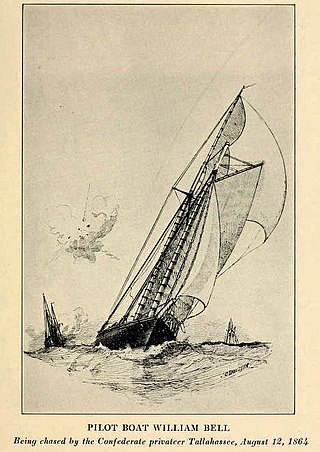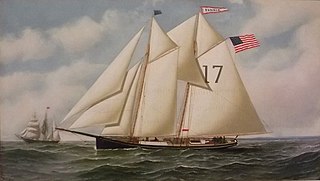
Joseph Henderson was a 19th-century American harbor pilot who guided large vessels into and out of New York Harbor as a Sandy Hook pilot. During his long career his work included bringing the ship that carried the Statue of Liberty safely into port after its trip from Europe, and was called upon as an expert seaman to determine the height of the water span of the Brooklyn Bridge, a new bridge from Brooklyn to New York City.

Pet No. 9 was a pilot boat used by the New York Sandy Hook Pilots in the 19th century. The schooner was used to pilot vessels to and from the Port of New York and New Jersey.

The William Bell was a pilot boat built in 1864 by shipbuilder Edward F. Williams at Greenpoint, Brooklyn for a group Sandy Hook Pilots. She was captured and burned by the Confederate raiding steamer CSS Tallahassee during the American Civil War. A second William Bell was constructed in 1864-1865 to replace the first one.

The Moses H. Grinnell was a 19th-century pilot boat built in 1850 for the New York maritime pilots. She was designed by the yacht designer George Steers. The Grinnell was the first pilot boat to feature a fully developed concave clipper-bow, which was to become the New York schooner-rigged pilot boat's trade mark. This new design was the basis for the celebrated yacht America.

The Fannie was a 19th-century Sandy Hook pilot boat built in 1860 by Edward F. Williams at his shipyard in Greenpoint, Brooklyn for New York City pilots. She was in the pilot service during the American Civil War. In an age of steam, she was sold in 1896.

The America, No. 21 was a 19th-century pilot boat built in 1880 for the New York City and Sandy Hook Pilots. She was a replacement for the William H. Aspinwall, No. 21, that was lost off Point Judith, Rhode Island in 1880. She weathered the Great Blizzard of 1888. In the time of steam, the America was sold in 1896 by the New York Pilots. A new pilot-boat America was built in 1897 for Captain James H. Reid of Boston and designed from the line drawings by Thomas F. McManus of Boston. After serving 21 years in the Boston Pilots' Association, the America was sold to David W. Simpson of Boston in 1918.

James Funk was a 19th-century New York City pilot boat built in 1862 at Greenpoint, Brooklyn for a company of New York Pilots. She was built for speed. She was assigned the "Number 22," which was displayed on her mainsail. The James Funk was captured and burned by the Confederate raiding steamer CSS Tallahassee during the American Civil War. The Charlotte Webb was built in 1865 to take the place of the James Funk that was destroyed.

The Washington was a 19th-century Sandy Hook pilot boat built in 1845 by C. & R. Poillon for New York Pilots. She was rebuilt several times, the last with the sail number "22" painted on her mainsail. In 1884, she was sunk by the German steamship Roma, and then replaced by a new Washington.

The Widgeon was a 19th-century yacht and Sandy Hook pilot boat, built in 1855 by James R. & George Steers for Daniel Edgar of the New York Yacht Club and designed by George Steers. She came in 17th in an unsuccessful America’s Cup defense in 1870. Widgeon was sold in 1871 to a group of New York pilots to replace the John D. Jones, which sank in a collision with the steamer City of Washington. New York pilots condemned the Widgeon as unseaworthy in 1879, which sparked a fight for steam pilot-boat service. In 1883 a decision was affirmed by the Supreme Court and the Board of Commissioners of Pilots that pilot boats could be "propelled" by steam.

The James M. Waterbury was a 19th-century Sandy Hook pilot boat built in 1843, at Williamsburgh, Brooklyn for a group of New York Pilots. She helped on many of the rescues along the New York Harbor. One of last reports of the James M. Waterbury was in 1867 when seaman James Roach fell overboard and was drowned off Fire Island.
The Mary Ann, No. 13 was a 19th-century Sandy Hook pilot boat built for the New York pilots. She helped transport maritime pilots between inbound or outbound ships coming into the New York Harbor. In 1860, the Mary Ann, was one of only twenty-one pilot boats in the New York and New Jersey fleet. She went ashore outside Sandy Hook in 1863.

The Nettle was a 19th-century Sandy Hook pilot boat built in 1844 by S. Hall of East Boston, Massachusetts for the New York Pilots. She helped transport maritime pilots between inbound or outbound ships coming into the New York Harbor. In 1868, she found the wreck of the bark Henry Trowbridge, and towed her to Sandy Hook. The Nettle, sank in 1876 in the Pensacola Bay. The sunken wreck was removed in 1878 to improve the Pensacola harbor.

The Anthony B. Neilson was a 19th-century Sandy Hook pilot boat, built in 1854 by George Steers for a company of New York Sandy Hook pilots. She was considered to be the fastest boat in the piloting business. She helped transport New York City maritime pilots between inbound or outbound ships coming into the New York Harbor. She survived the Great Blizzard of 1888. In 1859, the Neilson was sold to a group of New Orleans pilots. The New York pilots then replaced the Neilson, with a new pilot boat, the John D. Jones.

The Mary E. Fish was a 19th-century Sandy Hook pilot boat, built at the Edward F. Williams shipyard of Greenpoint, Brooklyn in 1861 for Richard Brown and the New York Pilots. She was built to replace the Mary Taylor. The Fish was hit and sank by the schooner Frank Harrington in 1885 and replaced by the David Carll.
The Blossom was a 19th-century Sandy Hook pilot boat built for the New York pilots around 1837. She helped transport maritime pilots between inbound or outbound ships coming into the New York Harbor. In 1839, she came across the Slave ship La Amistad. In 1840, there were only eight New York pilot boats, the Blossom being No. 5. Pilot Thomas Freeborn of the Blossom boarded the packet ship John Minturn and tried to guide the ship in bad weather. He was one of thirty-eight passengers that died near the Jersey Shore in 1846.

Josiah Johnson, Jr., was a 19th-century American New York Sandy Hook maritime pilot. He was best known for being in the New York Sandy Hook piloting service for over 47 years. He piloted over 5,000 vessels in and out of the New York Harbor without an accident. Johnson was captain and owner of the pilot boat Edmund Blunt.

Theophilus Beebe III was a 19th-century American Sandy Hook Pilot. He was the first pilot to receive his pilot's license under the New Jersey Pilots' Commission in 1837. Beebe served as pilot on the pilot boat Thomas H Smith. He died on January 9, 1867, in Jersey City, New Jersey.
James Callahan was a 19th-century American New York Sandy Hook Pilot. He is well known for being one of the oldest Sandy Hook pilots, having served for 38 years. He was owner and operator of the William Bell that was captured and burned by the Confederate raiding steamer CSS Tallahassee during the American Civil War.

The Adriatic was a three-masted, two deck, packet ship built in 1861 by Curtis & Tilden, Boston, Massachusetts, United States. On August 12, 1864, the Adriatic was embarked from London, England en route to New York City carrying 163 German immigrants and 100 US citizens. She made it as far as the New Jersey coast before meeting the Confederate raider CSS Tallahassee, that collided with her. Captain John Taylor Wood of Tallahassee ordered every passenger on the Adriatic to be taken prisoner and put on the Tallahassee. Wood then ordered the Adriatic to be burned.















